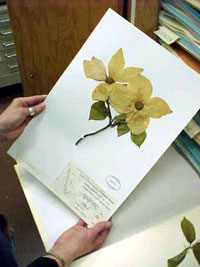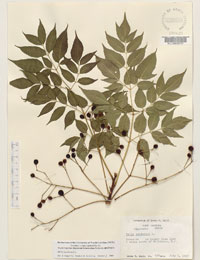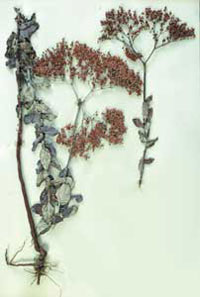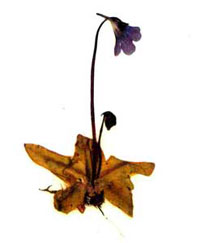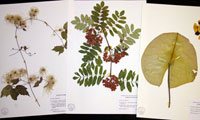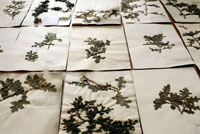Herbarium
In botany, a herbarium is a collection of preserved plant specimens. These specimens may be whole plants or plant parts: these will usually be in a dried form, mounted on a sheet, but depending upon the material may also be kept in alcohol or other preservative. The same term is often used in mycology to describe an equivalent collection of preserved fungi.
The term can also refer to the building where the specimens are stored, or the scientific institute that not only stores but researches these specimens. The specimens in a herbarium are often used as reference material in describing plant taxa; some specimens may be types.
A xylarium is a herbarium specialising in specimens of wood. A hortorium (as in the Liberty Hyde Bailey Hortorium) is one specialising in preserved specimens of cultivated plant.
Specimen preservation
Certain groups of plants are soft, bulky, or otherwise not amenable to drying and mounting on sheets. For these plants, other methods of preparation and storage may be used. For example, conifer cones and palm fronds may be stored in labeled boxes. Representative flowers or fruits may be pickled in formaldehyde to preserve their three-dimensional structure. Small specimens, such as mosses and lichens, are often air-dried and packaged in small paper envelopes.
No matter the method of preservation, detailed information on where and when the plant was collected, habitat, color (since it may fade over time), and the name of collector is usually included.
Collections management
Locating a specimen filed in the herbarium requires knowing the nomenclature and classification used by the herbarium. It also requires familiarity with possible name changes that have occurred since the specimen was collected, since the specimen may be filed under an older name.
Modern herbaria often maintain electronic databases accessible via the Internet.
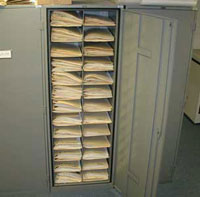 In Australia, each state and territory jurisdiction has a Herbarium, with the Australian National Herbarium in the national capital Canberra.
In Australia, each state and territory jurisdiction has a Herbarium, with the Australian National Herbarium in the national capital Canberra. The Northern Territory has over 4,100 species of native plants including some 567 endemic species, many of which are of conservation significance. With the Territory comprising approximately 1/6 th of the Australian land area (or 1.335 million km2) across a range of topographic, edaphic and climate conditions, there is also a great diversity of vegetation communities.
Uses of Herbarium
Herbaria are essential for the study of plant taxonomy, the study of geographic distributions, and the stabilizing of nomenclature. Thus it is desirable to include in a specimen as much of the plant as possible (e.g., flowers, stems, leaves, seed, and fruit). Linnaeus' herbarium now belongs to the Linnean Society in England.Specimens housed in herbaria may be used to catalogue or identify the flora of an area. A large collection from a single area is used in writing a field guide or manual to aid in the identification of plants that grow there. With more specimens available, the author of the guide will better understand the variability of form in the plants and the natural distribution over which the plants grow.
Many kinds of scientists use herbaria to preserve voucher specimens; representative samples of plants used in a particular study to demonstrate precisely the source of their data.
They may also be a repository of viable seeds for rare species.
72 Uses of Herbarium
For the past year or so I have been keeping a list of uses of herbaria. Two recent events have greatly increased that list. First, I published an article titled “The Importance of Herbaria” (Funk, 2003), and after it came out a number of my colleagues sent in additional uses. Second, I attended a workshop about natural history collections (see below), and in preparing for the workshop the list increased to ca. 50. During the workshop additional uses were mentioned, and the current total stands at 72. Hopefully the list will grow to 100 after this article is published. If you would like to use this list you can download it on line at the Biological Diversity of the Guianas web site (Hollowell et al., 2003) but please also send any additions or corrections to me so that I can update the site.
Herbaria, dried pressed plant specimens and their associated collections data, ancillary collections (e.g., photographs) and library materials, are remarkable and irreplaceable sources of information about plants and the world they inhabit. They provide the comparative material that is essential for studies in taxonomy, systematics, ecology, anatomy, morphology, conservation biology, biodiversity, ethnobotany, and paleobiology, as well as being used for teaching and by the public. They are a veritable gold mine of information and the foundation of comparative biology. According to the updated website of Index Herbariorum (Holmgren & Holmgren, 2003), there are 3240 herbaria in the world. Just in the USA there are more than 60 million specimens in 628 herbaria (Funk and Morin, 2000). At the US National Herbarium (National Museum of Natural History, Smithsonian Institution) there are nearly 5 million specimens, and, just for the record, about 500,000 of the US specimens are in the Compositae.
Recent articles have highlighted the problems that are being faced by state and university natural history collections, including herbaria. An article from Nature (Dalton, 2003) and one from BioScience (Gropp, 2003) make it clear that natural history collections are being targeted unfairly in the current budget crises in states and universities. From Los Angeles to Iowa, Nebraska and Virginia, natural history collections are being closed or given away and the staff either re-assigned or fired. All of this has a negative impact on our ability to train systematists (Gropp 2003) and causes much concern over the fate of organismal biology. Hopefully lists such as this one will help those fighting to save their collections from death or dismemberment.
Basic Functions & Research
- discover or confirm the identity of a plant or determine that it is new to science (taxonomy);
- document the concepts of the specialists who have studied the specimens in the past (taxonomy);
- provide material for making morphological measurements (taxonomy, systematics);
- provide locality data for planning field trips (taxonomy, systematics, teaching);
- provide data for floristic studies (taxono my);
- serve as a repository of new collections (taxonomy and systematics);
- provide data for revisions and monographs (systematics);
- verify plant Latin names (nomenclature);
- serve as a secure repository for "type" specimens (taxonomy);
- provide infrastructure for obtaining loans etc. of research material (taxonomy and systematics);
- facilitate and promote the exchange of new material among institutions (taxonomy);
- allow for the documentation of flowering and fruiting times and juvenile forms of plants (taxonomy, systematics, ecology, phenology);
- provide the basis for an illustration of a plant (taxonomy and general publishing);
- provide material for DNA analysis (systematics, evolution, genetics);
- provide information for GIS studies of past and future collecting expeditions (taxonomy, ecology, etc.);
- house vouchers for photographs that can be used in lectures, web sites, and publications (taxonomy);
- provide information on rare, extirpated, or extinct species that can no longer be found in nature (taxonomy, conservation biology);
- provide modern specimens for comparisons with fossils (e.g. classification of leaf patterns; paleobotany);
- to trace the history of usage of binomials for a given tax
on in a given area (local flora);
- provide pollen for taxonomic, systematic, and pollination studies as well as allergy studies (taxonomy, systematics, pollination ecology, insect ecology, and medical studies);
- provide reference samples for the identification of plants eaten by animals (animal ecology);
- determine native ranges and document which plants grew where through time (invasive species, climate change, habitat destruction, etc.)
- document what plants grew with what other plants (phytogeography, ecology);
- provide material for microscopic observations (anatomy and morphology);
- document the morphology and anatomy of individuals of a particular species in different locations (environmental variation);
- serve as a repository for voucher specimens (ecology, ethnobotany, environmental impact studies, etc.);
- provide material for chemical analysis (lead-uptake; pollution documentation; bio-prospecting, for coralline algae - determining past ocean temperatures and chemical concentration);
- provide information for studies of expeditions and explorers (history of science);
- provide the label data and field notebooks necessary for accurate data-basing of specimens (biodiversity and conservation biology, biogeography);
- serve as a reference library for the identification of part s of plants (e.g., seeds) found in archeology digs (paleoethnobotany);
- provide context for accompanying library and other bibliographic resources (library sciences, general research, taxonomy, etc.);
- serve s an archive for related material (field notebooks, letters, reprints, etc.);
- provide information on common names and local uses of plants (anthropology, linguistics, ethnobotany, economic botany);
- provide insect collections that have been incidentally collected along with the plants (entomology, ecology);
- serve as a means of locating rare or possibly extinct species via recollecting areas listed on label data (conservation biology, environmental impact statements, endangered species, etc.);
- provide information on plant predators (e.g., leaf miners, leaf-cutter ants; entomology, ecology);
- establish the presence and distribution of plant diseases (e.g. anther-smut);
- track introduction and spread of invasive species (ecology);
- document CO2 change over past 10,000 to 10,000,000 years, a more precise proxy for this than ice core data (climate change);
- provide information for foliar physiognomy studies of leaf form as it is related to climate change (paleoecology);
- to document polyploid populations that occur natura lly by leaf and epiderml stomatal complex size (phylogeography, paleoecology);
- to document fungal/vascular plant symbionts;
- to document biogeography of past plant distributions including regional extinctions (paleobiogeography);
- document the evolution of major groups of vascular plants (paleobotany);
- document minor cycles in climate (paleoecology);
- provide carbon isotope ratios (e.g., Lewis and Clark specimens from 200 years ago have increased C12) (climate change);
Education & Training
- provide material for teaching (botany, taxonomy, field botany, plant communities; ethnobotany; agriculture; dendrology, forestry);
- promote appreciation of botanical diversity by making specimens available for viewing by students, researchers, and the public.
- provide internship and job opportunities for undergraduate and graduate students
- provide opportunities for students and young scientists to meet more established scientists;
- expose students to systematic research;
- train local volunteers for specimen handling, scanning, and databasing etc.;
- run education courses for the public (e.g. local plant families)
Outreach
- serve as an identification center for all kinds of plants parts for many different groups of individuals, e.g., samples for the identification of plants that may be significant to criminal investigations (forensics);
- serve as an educational tool for the public (garden clubs, school groups, etc.);
- provide a focal point for botanical interactions of all types (lectures, club meetings, etc.);
- provide samples for museum and educational exhibits;
- provide a location for government and state agencies to work on specimens, i.e., USDA, USGS, NPS;
- provide a home for long-term initiatives (e.g. Smokey Mt. NP ATBI);
- provide a home for global, regional or local studies;
- help establish new museums;
- foster good international relations (e.g. sister institutions, joint field tribs);
- provide material for the public (e.g. accurate illustrations);
- provide inspiration for painters;
- interact with the local people to form volunteer groups for conservation efforts;
- maintain websites for dispersing specimen information, databases, images, public service information;
- repatriate data and images from collections to the country where they were collected (international relations);
- help artists prepare accurate drawings for children's books;
- provide information on the wild relatives of cultivated plants;
- facilitate international exchanges of field expeditions;
- organize photographs of plants associated with voucher collections;
- help design natural history products for sale in gift shops (e.g. old illustrations for note cards);
- Dalton, R. 2003. Natural history collections in crisis as funding is slashed. Nature 423: 575.
- Funk, V. A. 2002. The Importance of Herbaria. Plant Science Bulletin 49: 94-95.
- Funk, V. A. & N. Morin. 2000. A survey of the herbaria of the southeast United States. SIDA, Misc. 18: 5-52.
- Gropp, R. E. 2003. Are university natural science collections going extinct? Bioscience 53: 550.
Largest herbarias
Many universities, museums, and botanical gardens maintain herbaria. Herbaria have also proven very useful as sources of plant DNA for use in taxonomy and molecular systematics. The largest herbaria in the world, in approximate order of decreasing size, are:- Muséum National d'Histoire Naturelle (P) (Paris, France)
- New York Botanical Garden (NY) (Bronx, New York, USA)
- Komarov Botanical Institute (LE) (St. Petersburg, Russia)
- Royal Botanic Gardens (K) (Kew, England, UK)
- Conservatoire et Jardin botaniques de la Ville de Genève (G) (Geneva, Switzerland)
- Missouri Botanical Garden (MO) (St. Louis, Missouri, USA)
- British Museum of Natural History (BM) (London, England, UK)
- Harvard University (HUH) (Cambridge, Massachusetts, USA)
- Swedish Museum of Natural History (S) (Stockholm, Sweden)
- United States National Herbarium (Smithsonian Institution) (US) (Washington, DC, USA)
- Nationaal Herbarium Nederland (L) (Leiden, the Netherlands)
- Université Montpellier (MPU) (Montpellier, France)
- Université Claude Bernard (LY) (Villeurbane Cedex, France)
- National Botanic Garden of Belgium (BR) (Meise, Belgium)
- University of Helsinki (H) (Helsinki, Finland)
- Botanischer Garten und Botanisches Museum Berlin-Dahlem, Zentraleinrichtung der Freien Universit» t Berlin (B) (Berlin, Germany)
- The Field Museum (F) (Chicago, Illinois, USA)
- University of Copenhagen (C) (Copenhagen, Denmark)
- Chinese National Herbarium, (Chinese Academy of Sciences) (PE) (Beijing, People's Republic of China)
- University and Jepson Herbaria (UC/JEPS) (Berkeley, California, USA)
- Herbarium Bogoriense (BO) (Bogor, West Java, Indonesia)
- Royal Botanic Garden, Edinburgh (E) (Edinburgh, Scotland, UK)
History of Herbarium
1802-1803The first plants to be collected in the NT for scientific description and naming were gathered in 1802-1803 by Robert Brown and his associates. Brown was naturalist on H.M.S. Investigator, captained by Matthew Flinders. Nearly three months were spent in NT waters. No fewer than 360 of the native plant species found in the NT were described by Brown.
1818-1821
Botanist and explorer Allan Cunningham accompanied Lieutenant Phillip Parker King on five survey voyages of coastal Australia carried out between 1817 and 1822 on the ships Mermaid and Bathurst. Cunningham collected in northern Australia on four of these voyages. 1839-1840 The officers of HMS Beagle (under Wickham and subsequently Stokes) carried out extensive exploration and survey work off the N and NW coast of Australia. Benjamin Bynoe was surgeon on board the Beagle and is generally considered to have been the principal collector of plants, but both John Clements Wickham and John Lort Stokes also collected.
Short-lived Settlements in the Top End
Fort Dundas, Melville Island (1824-1829) A small collection was made on Melville Island by a convict botanical collector, John Richardson.
Victoria Settlement, Port Essington (1838-1849) Thomas Huxley visited Port Essington during the voyage of HMS Rattlesnake. He described it as
- the most useless, miserable, ill-managed hole in Her majesty's dominions [deserving of] all the abuse that has ever been heaped upon it ... fit for neither man nor beast. Day and night there is the same fearful damp depressing heat, producing unconquerable langour and rendering the unhappy resident a prey to ennui and cold brandy and water ... Port Essington is worse than a ship, and it is no small comfort to know that this is possible.
John Gilbert gathered plant specimens from Port Essington in 1840-41.
John Armstrong was a collector and gardener at Victoria Settlement. He collected more than a 1,000 specimens in the Cobourg area. The common cycad of the Darwin region, Cycas armstrongii, is one of about seven species that were named after him.
Ludwig Leichhardt in 1844-1845 made a successful crossing from Moreton Bay to Port Essington and in so doing contributed to the knowledge of Top End plants. Loss of transport, due to the death of horses and oxen, meant that he had to abandon between 3,000 and 6,000 specimens.
Palmerston, Escape Cliff (1864-1867)
In January 1866 John McKinlay attempted to explore the region east of the Adelaide River. With the onset of the wet season travel was slow and the lower reaches of the East Alligator River were not met until June. A push further east was thwarted by boggy ground and rough terrain and with supplies all but exhausted the horses were killed and their hides used in the construction of a raft, christened the Pioneer. Fending off attacks by crocodiles attracted by the rotting hides, the party successfully sailed down the East Alligator and along the coast before returning to Escape Cliff. McKinlay gathered a few plant specimens for Ferdinand Mueller in Melbourne.The collector Hulls, probably Charles Hulls, also made important collections in the country around Escape Cliff.
The Overland Expeditions (1855-1911)
North Australian Exploring Expedition (1855-1856) Under the leadership of Augustus Charles Gregory the North Australian Expedition travelled from the Victoria River region down to Sturt Creek in Western Australia before travelling to the Roper River and further east to the Nicholson River on the Queensland border and onto Brisbane. From a botanical viewpoint this was the most important of all the overland expeditions in the NT, with Ferdinand Mueller, the Melbourne-based botanist, making large collections and naming many species. About 300 Top End plants were named by Mueller. These include the boab, Adansonia gregorii.Gregory, John Ravenscroft Elsey, James Flood and James Spottiswood Wilson, also collected specimens during the expedition.
John McDouall Stuart (1860-1862)
Ernest Giles (1872-1876)
A major explorer of the deserts of central Australia, Giles, and sometimes his associates, gathered important collections for Ferdinand Mueller. One of his best known discoveries is of the cabbage palm of central Australia. He collected more than 250 species and about 40 of these were new to science.Other explorers who collected herbarium specimens in the NT include William Gosse (1873), Alexander Forrest & James Carey (1879) and Henry Tietkens (1889-1890).
Collectors associated with the Overland Telegraph
The construction of the Overland Telegraph Line not only connected the Australian colonies to the world but enhanced the plant collections of the Melbourne herbarium. Alfred Giles, was involved in expeditions to fix the course of the telegraph (and was subsequently at Springvale Station at Katherine), as was his brother Christopher Giles, who was a surveyor. Both collected specimens for Mueller. Some men who staffed the telegraph stations - Ernest Flint, Frank Gillen and J.C. Chandler - also collected plants.Scientific Expeditions
Horn Scientific Exploring Expedition (1894) This expedition, to the McDonnell Range region, was organised by mining magnate William Austin Horn, and was under the command of Charles Winneke. The party included six scientists, including as botanist, Professor Ralph Tate.Expedition members were assisted by a number of local people, including Frank Gillen, the post and telegraph stationmaster at Alice Springs. His meeting with Professor Baldwin Spencer was arguably the most important result of the expedition, the two men subsequently collaborating in major anthropological studies.
Tate named the grass-tree Xanthorrhoea thorntonii in compliment to Robert Thornton of Tempe Downs "who at considerable trouble was the first to bring this grass-tree to my notice, and in other directions greatly forwarded the objects of the Expedition". This was one of eight new species of plant described as a result of the Horn Expedition.
The same year of the Horn Expedition Gillen wrote to Spencer about an attempt to collect plants:
- We are getting a very nice collection of plants together but I am afraid nothing new. My wind is not good enough for climbing the high ranges. I have no taste for such violent exercise even if my wind were right. I am however anxious to get a good collection from the Mt Gillen range and with that purpose in view I sent one of my Boys out the other day and instructed him to fill a bag with all sorts of different flowering plants and pretty grasses. He did so and [upon returning] emptied the contents of the bag into the horse yard where one of my thorough breds happened to be kept for the night. An hour or two afterwards he grinningly informed me, "Me bin Giveum Grass longa Nanto." The atmosphere was blue with profanity for half an hour afterwards ...
G. F. Hill and the Barclay Expedition
Gerald Freer Hill in 1911 was appointed as naturalist and photographer to an expedition under Henry Vere Barclay. The expedition travelled from Adelaide to Borroloola. He collected more than 600 specimens during the expedition.Schultz
Described as "a special and successful emissary of the Adelaide Botanic Gardens [who] traversed for botanical collecting purposes the vicinity of Port Darwin" F. Schultz collected type specimens of nearly 30 species. The collections were apparently made when he accompanied Goyder's survey party in 1868-1869.In 1882 Professor Ralph Tate of The University of Adelaide accompanied aSouth Australian parliamentary party which was investigating the commercial prospects of the Top End. They travelled from Darwin to Pine Creek area and Tate collected a number of plants.
Other specimens were collected in the Top End during small expeditions, including those by G.H. Wilkins (Crocodile Islands and Groote Eylandt 1924-1925) and H. Basedow (in 1928 with D. Mackay).
Northern Territory Settlements and their Collectors (post 1868-to c. 1914)
With the development of permanent settlements resident collectors began to make important contributions to the knowledge of plants in the NT.The Hermannsburg Collectors
The Lutheran Church established the Hermannsburg Mission in 1877. Two of the original founders were Friederich Adolf Herman Kempe and W.F. Schwarz and along with Louis Schulze, who joined the mission in 1878, they collected plants for Ferdinand Mueller in Melbourne. Carl F. T. Strehlow, appointed to the mission in 1894, also collected plants.Kempe is honoured in several plant names, including Acacia kempeana, the witchetty bush.
Foelsche
Born in Germany, Paul Heinrich Matthias Foelsche emigrated to South Australia and in 1870 he arrived in Darwin. He spent the rest of his life in the NT and held the office of Inspector of Police for many years. Foelsche made important studies of Aboriginal customs and language and compiled a large photographic record of life in the Territory. He also collected plants, on occasions with his friend Maurice Holtze. Collections included a type specimen of the bloodwood Corymbia foelscheana.Maurice and Nicholas Holtze
Maurice Holtze was government gardener of the Palmerston Botanic Gardens (i.e. today's George Brown Darwin Botanic Gardens) from 1878 to 1891 and he was succeeded as head of the Garden by his son Nicholas. Both father and son collected plant specimens.Other collectors for this time include J.E. Tennison-Woods (1886, with Maurice Holtze), J.H. Niemann, E.J. Dunn and R.J. Winters (1904, 1913) and W.S. Campbell (1911).
Collectors post 1914
With the death of Nicholas Holtze and the advent of WW I, there was a hiatus in collecting activity. Leading up to 1954 collectors included C.E.F. Allan, appointed as Curator of the Botanic Gardens in 1913, H.I. Jensen, Rev. S.T. Lea, L.J. Brass, Robert Stott (policeman in Alice Springs), H. Basedow and Florenz August Karl Bleeser (of the Australian Post Office).As a result of visits by interstate botanists, pastoral surveys and the establishment of herbaria in Alice Springs (1954) and Darwin (1966), hundreds of people have now collected plants in the NT and lodged them in herbaria. In doing so, all have added to our knowledge of plants, particularly our knowledge of the distribution of species.
